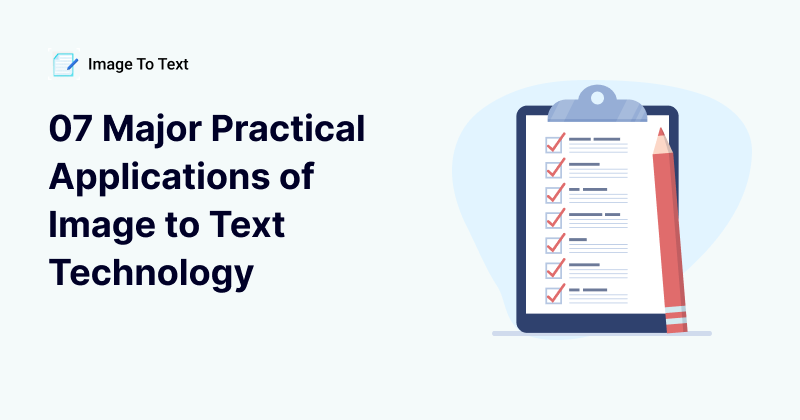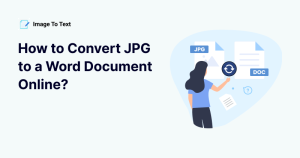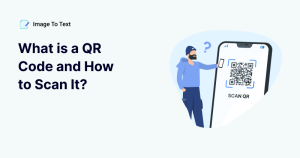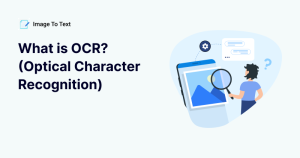07 Major Practical Applications Of Image To Text Technology
Experts slate the global OCR market to reach around $22 million in 2027. While the next five years are definitely important for these image to text technologies, the current era doesn't need them any less. In today's world, the practical implications of OCR have become a necessity.
Students need it, businesses want it, and everyone uses it. This versatile technology is almost a century old, but it never stops to evolve. Embracing our phones, OCR allows us to capture text from any image we wish.
Whether we extract writings from a book or jokingly capture text present on a nearby billboard, we have OCR in the palm of our hands. But, how exactly does it affect us practically?
What are its major implications in our lives? Let's go into the depths of this tech and understand just how it helps us.
What is Image To Text Technology?
Image to text technology or OCR is an exceptional tech that allows users to extract text from images. The process behind this technology recognizes each character present on a text or image, hence the name. Then, through an intricate process, it turns those characters into words.
Document processing allows the program to place one character after another, forming words, then sentences, then passages, and so on. This process allows the person using this technology to copy or extract necessary data present in image or document form.
So, how exactly does it do that? It follows an intricate procedure, which includes a variety of elements. From recognizing character to preparing the final document, it follows a six-step procedure, which is:
Pre-processing
The program and hardware start with pre-processing, where they recognize the text as a whole. At this point, the machine or the tool itself hasn't yet started recognizing characters, as it's still processing the places where text is present on an image or paper.
This pre-processing allows the tool to know just which places to scan. So, it doesn't bother itself by scanning empty spaces. Moreover, it also prepares the expected word/character count by pre-processing.Text Lines
Once it recognizes the amount of text present in an image, it begins forming text lines. This way, the tool only has to fill these lines once the OCR comes into play. These text lines are akin to how you would formulate sentences.
So, before placing each word on the screen, the program recognizes the lines where it belongs. This lining allows the program to accurately identify each word on the final extract, ensuring that it's akin to the words and their formation on paper.Character Imaging
In this phase, OCR or the 'optical' part of character recognition switches itself on. It starts to envision characters as they are present in the image. Once done, it begins rewriting them in the same virtual form.
While machine-written or typed text will be easier to read for the AI in this tool, character imaging allows handwritten text to be extracted easily. This character imaging is basically the program copying the character's shape as it portrays itself on paper.Extraction
This phase begins to extract character after character, including spaces, whether handwritten or typed. Then it formulates the extraction, carefully placing each character into its place—forming a full-fledged word each time.
The extraction process is complete once the program analyses each word and copies them into its virtual form. This process takes the most time out of any other on this list of procedures.Section/Classify
Once the character extraction is through, the program/tool identifies them and places them into their respective places.
This process ensures the tool places the text in the places according to the source image or text. In other words, it formulates sentences, paragraphs, etc.Final Product
When all the elements as mentioned above are done, the tool or the app will present you with the final text. This will most likely be in the shape of a text editor, which allows you to download PDF or Docx files.
7 Applications Of Image-To-Text Conversion
The process of image-to-text conversion takes up to about 5-10 seconds max. While these tools are easy to find, they aren't all necessarily reliable. That's why you need to pick a viable image to text tool that thoroughly employs the procedure mentioned above.
However, is it worth going through all the trouble? What are even the applications of extracting text from images today? In both academic and professional settings, the requirement of extracted text is becoming more and more significant. That's why it's necessary to use them.
But, to help you understand why they're essential and their application, we formulated a list of seven essential elements. Each one of these helps a specific group of writers, educators, professionals, businesses, marketers, or academia. So, let's dive in.
Forming Vast Databases
A database of information, whether in businesses or schools, is a necessity. It's not only an important essential to access information, but it's also required so that professionals and students can benefit from it equally. However, turning physical text into virtual libraries isn't an easy task.
That is until you employ an image-to-text converter. Using such a tool enables you to use the vast data available in text form. These scanned documents can form extensive databases essential for academic and professional use.
Moreover, for a business, these elements can prove vital in case of a need to access old information. On the other hand, academies benefit from it by providing necessary information to their educators and students.Boosting Productivity
Imagine sitting down and writing a textbook in its virtual form. It would take days before even the most proficient writer could muster all the words from text into the computer. It's not only tiring, but it's also a highly dull procedure.
So, besides compromised time efficiency, you will have an employee, i.e., a writer, who hates their job. That's something no workplace can afford. Moreover, it also hinders efficiency. That's why it's essential to use the image to text conversion to boost productivity.
Many businesses virtualize their necessary data and form vast cybernetic libraries using these tools. Doing so also creates a flow of productivity by ensuring everyone instantly accesses essential information.Creating Data Indexes
Besides databases, data indexes are just as important. While they're two sides of the same coin, data index allows the user to access the database thoroughly and look for just the type of information or data they need. This materialized approach helps both businesses and academics.
Many universities and colleges have turned their physical textbook libraries into virtual ones in recent times. While the pandemic is partly the reason behind this, the need for vast spaces also plays a role. Because it lets academies reduce extended library shelves into the hard drive(s).
So, these data indexes aren't only vital for students, but educators themselves benefit from them just as much. Reading just the suitable material at the time it is needed ensures better productivity and ease of access.Easier For Content Creation
It's a necessity for businesses to stand out with viable content creation. It requires information, resources, and all the data that they can muster for their writers. That's when textbooks or physical forms of written work get in the way.
Or do they? Because many businesses employ OCR just to prevent this and use the information present in physical shape. By using image-to-text conversion, businesses use all the data they have to ease content creation.
This allows for viable blogs, website copies, and social media content. Which isn't only a necessity in marketing but also for brand voice and recognition. All of this is made easy just because OCR has vast implications in business.Data Automation
Data automation is a necessity in academic and professional settings. Whether you talk about emails, study programs, blogs, websites, etc., data automation is everywhere. That's why many colleges and universities rely heavily on using these converters.
On the other hand, businesses use these text extractors to build data libraries, allowing them to achieve high-quality data automation. These necessary elements create a flow of data for the audience, as well as for the business.Improved Accessibility
If you're looking for information on blog websites, it's easy to just Google them. However, if you wish to find information from books or manuscripts, then it becomes a highly tiring exercise. That's one of the reasons many people use image to text converters.
These tools allow the user to easily access said databases. By finding pertaining information within these texts, it improves accessibility tenfold. This doesn't only let the user of these tools stand out with a sea of knowledge but also unimpeded access to said information.Cost-Saving Properties
One of the most critical elements in professional settings and academia is to save as much cost as possible. By using such a convenient technology, many employers face the challenge of finding themselves paying huge bills.
However, that's not the case with image to text conversion, as it's practically free. Even the paid programs will not break the bank. This alone makes the OCR technology one of the best and most cost-effective technologies available today.
Final Word
These elements and applications of OCR in business and academia help thousands of people every day. These programs are easily available for the standard user with mobile and web apps.
This alone makes this almost-hundred-year-old technology a remarkable tool for today's writers, students, professionals, and educators. In addition, their unending application in various elements makes an image-to-text converter a must-have for people in all facets of life.




